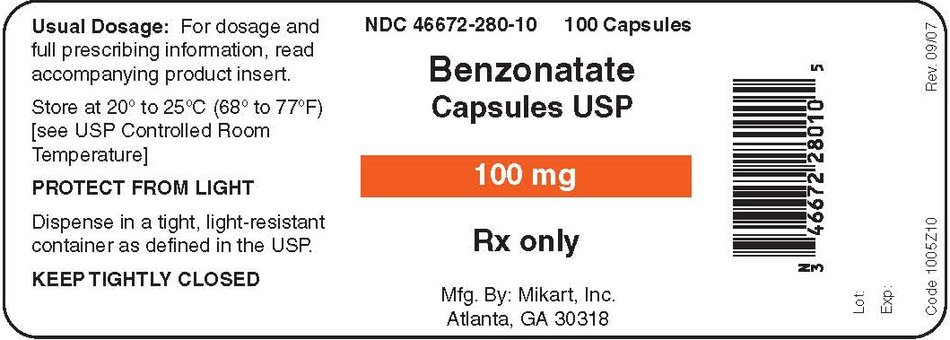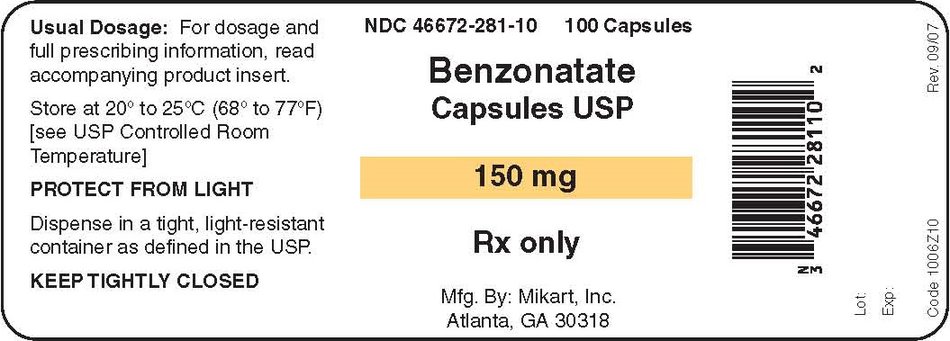benzonatate by Mikart, LLC BENZONATATE capsule
benzonatate by
Drug Labeling and Warnings
benzonatate by is a Prescription medication manufactured, distributed, or labeled by Mikart, LLC. Drug facts, warnings, and ingredients follow.
Drug Details [pdf]
-
DESCRIPTION
Benzonatate, a non-narcotic oral antitussive agent, is 2, 5, 8, 11, 14, 17, 20, 23, 26-nonaoxaoctacosan-28-yl p-(butylamino) benzoate; with a molecular weight of 603.00 (av).
Each capsule, for oral administration, contains benzonatate in the following strengths: 100 mg, 150 mg or 200 mg.
All strengths contain the following inactive ingredients: colloidal silicon dioxide, croscarmellose sodium, hydroxypropyl cellulose, microcrystalline cellulose, and silicon dioxide. Capsule shells for all strengths are composed of gelatin, titanium dioxide, FD&C Blue #1 and the following: FD&C Yellow #6, FD&C Red #40 (100 mg, 200 mg), D&C Red #28 (150 mg, 200 mg). Imprinting ink is composed of black iron oxide, butly alcohol, dehydrated alcohol, isopropyl alcohol, potassium hydroxide, propylene glycol, purified water, shellac and strong ammonium solution.
-
CLINICAL PHARMACOLOGY
Benzonatate acts peripherally by anesthetizing the stretch receptors located in the respiratory passages, lungs, and pleura by dampening their activity and thereby reducing the cough reflex at its source. It begins to act within 15 to 20 minutes and its effect lasts for 3 to 8 hours. Benzonatate has no inhibitory effect on the respiratory center in recommended dosage.
- INDICATIONS AND USAGE
- CONTRAINDICATIONS
-
WARNINGS
Hypersensitivity
Severe hypersensitivity reactions (including bronchospasm, laryngospasm and cardiovascular collapse) have been reported which are possibly related to local anesthesia from sucking or chewing the capsule instead of swallowing it. Severe reactions have required intervention with vasopressor agents and supportive measures.
Psychiatric Effects
Isolated instances of bizarre behavior, including mental confusion and visual hallucinations, have also been reported in patients taking benzonatate in combination with other prescribed drugs.
Accidental Ingestion and Death in Children
Keep benzonatate out of reach of children. Accidental ingestion of benzonatate resulting in death has been reported in children below age 10. Signs and symptoms of overdose have been reported within 15 to 20 minutes and death has been reported within one hour of ingestion. If accidental ingestion occurs, seek medical attention immediately (see OVERDOSAGE).
-
PRECAUTIONS
Benzonatate is chemically related to anesthetic agents of the para-amino-benzoic acid class (e.g., procaine; tetracaine) and has been associated with adverse CNS effects possibly related to a prior sensitivity to related agents or interaction with concomitant medication.
Information For Patients
Swallow benzonatate capsules whole. Do not break, chew, dissolve, cut, or crush benzonatate capsules. Release of benzonatate from the capsule in the mouth can produce a temporary local anesthesia of the oral mucosa and choking could occur. If numbness or tingling of the tongue, mouth, throat, or face occurs, refrain from oral ingestion of food or liquids until the numbness has resolved. If the symptoms worsen or persist, seek medical attention.
Keep benzonatate out of reach of children. Accidental ingestion resulting in death has been reported in children. Signs and symptoms of overdose have been reported within 15 to 20 minutes and death has been reported within one hour of ingestion. Signs and symptoms may include restlessness, tremors, convulsions, coma and cardiac arrest. If accidental ingestion occurs, seek medical attention immediately.
Overdosage resulting in death may occur in adults.
Do not exceed a single dose of 200 mg and a total daily dosage of 600 mg. If you miss a dose of benzonatate, skip that dose and take the next dose at the next scheduled time. Do not take 2 doses of benzonatate at one time.
Nursing Mothers
It is not known whether this drug is excreted in human milk. Because many drugs are excreted in human milk caution should be exercised when benzonatate is administered to a nursing woman.
-
ADVERSE REACTIONS
Potential Adverse Reactions to benzonatate may include:
Hypersensitivity reactions including bronchospasm, laryngospasm, cardiovascular collapse possibly related to local anesthesia from chewing or sucking the capsule.
CNS: sedation; headache; dizziness; mental confusion; visual hallucinations.
GI: constipation; nausea; GI upset.
Dermatologic: pruritus; skin eruptions.
Other: nasal congestion; sensation of burning in the eyes; vague "chilly" sensation; numbness of the chest; hypersensitivity.
Deliberate or accidental overdose has resulted in death, particularly in children.
-
OVERDOSAGE
Intentional and unintentional overdose may result in death, particularly in children.
The drug is chemically related to tetracaine and other topical anesthetics and shares various aspects of their pharmacology and toxicology. Drugs of this type are generally well absorbed after ingestion.
Signs And Symptoms
The signs and symptoms of overdose of benzonatate have been reported within 15 to 20 minutes. If capsules are chewed or dissolved in the mouth, oropharyngeal anesthesia will develop rapidly, which may cause choking and airway compromise.
CNS stimulation may cause restlessness and tremors which may proceed to clonic convulsions followed by profound CNS depression. Convulsions, coma, cerebral edema and cardiac arrest leading to death have been reported within 1 hour of ingestion.
Treatment
In case of overdose, seek medical attention immediately. Evacuate gastric contents and administer copious amounts of activated charcoal slurry. Even in the conscious patient, cough and gag reflexes may be so depressed as to necessitate special attention to protection against aspiration of gastric contents and orally administered materials. Convulsions should be treated with a short-acting barbiturate given intravenously and carefully titrated for the smallest effective dosage. Intensive support of respiration and cardiovascular-renal function is an essential feature of the treatment of severe intoxication from overdosage.
Do not use CNS stimulants.
-
DOSAGE AND ADMINISTRATION
Adults and Children over 10 years of age: Usual dose is one 100 mg, 150 mg or 200 mg capsule three times a day as needed for cough. If necessary to control cough, up to 600 mg daily in three divided doses may be given. Benzonatate capsules should be swallowed whole. Benzonatate capsules are not to be broken, chewed, dissolved, cut or crushed.
-
HOW SUPPLIED
Benzonatate Capsules USP is supplied as follows:
100 mg
Opaque white body and opaque light green cap imprinted “BZT” on the body and “326” on the cap, in black ink, in bottles of 100 capsules, NDC: 46672-280-10; and 500 capsules, NDC: 46672-280-50
150 mg
Opaque white body and opaque light blue cap imprinted “BZT” on the body and “331” on the cap, in black ink, in bottles of 15 capsules, NDC: 46672-281-95; 100 capsules, NDC: 46672-281-10; and 500 capsules NDC: 46672-281-50
200 mg
Opaque light blue body and opaque light green cap imprinted “BZT” on the body and “325” on the cap, in black ink, in bottles of 100 capsules, NDC: 46672-282-10; and 500 capsules, NDC: 46672-282-50
Store at 20º to 25º C (68º to 77ºF) [see USP Controlled Room Temperature]
PROTECT FROM LIGHT
Dispense in a tight, light-resistant container as defined in the USP. Keep tightly closed.
Manufactured by:
Mikart, LLC
Atlanta, Georgia 30318
Code 1005Z00
Rev. 03/19
- Package/Label Display Panel
- Package/Label Display Panel
- Package/Label Display Panel
-
INGREDIENTS AND APPEARANCE
BENZONATATE
benzonatate capsuleProduct Information Product Type HUMAN PRESCRIPTION DRUG Item Code (Source) NDC: 46672-280 Route of Administration ORAL Active Ingredient/Active Moiety Ingredient Name Basis of Strength Strength BENZONATATE (UNII: 5P4DHS6ENR) (BENZONATATE - UNII:5P4DHS6ENR) BENZONATATE 100 mg Inactive Ingredients Ingredient Name Strength SILICON DIOXIDE (UNII: ETJ7Z6XBU4) CROSCARMELLOSE SODIUM (UNII: M28OL1HH48) HYDROXYPROPYL CELLULOSE (TYPE L) (UNII: UKE75GEA7F) CELLULOSE, MICROCRYSTALLINE (UNII: OP1R32D61U) GELATIN (UNII: 2G86QN327L) TITANIUM DIOXIDE (UNII: 15FIX9V2JP) FD&C BLUE NO. 1 (UNII: H3R47K3TBD) FD&C YELLOW NO. 6 (UNII: H77VEI93A8) FD&C RED NO. 40 (UNII: WZB9127XOA) Product Characteristics Color green Score no score Shape CAPSULE Size 10mm Flavor Imprint Code BZT;326 Contains Packaging # Item Code Package Description Marketing Start Date Marketing End Date 1 NDC: 46672-280-10 100 in 1 BOTTLE; Type 0: Not a Combination Product 11/09/2009 2 NDC: 46672-280-50 500 in 1 BOTTLE; Type 0: Not a Combination Product 11/09/2009 Marketing Information Marketing Category Application Number or Monograph Citation Marketing Start Date Marketing End Date ANDA ANDA040851 11/09/2009 BENZONATATE
benzonatate capsuleProduct Information Product Type HUMAN PRESCRIPTION DRUG Item Code (Source) NDC: 46672-281 Route of Administration ORAL Active Ingredient/Active Moiety Ingredient Name Basis of Strength Strength BENZONATATE (UNII: 5P4DHS6ENR) (BENZONATATE - UNII:5P4DHS6ENR) BENZONATATE 150 mg Inactive Ingredients Ingredient Name Strength SILICON DIOXIDE (UNII: ETJ7Z6XBU4) CROSCARMELLOSE SODIUM (UNII: M28OL1HH48) HYDROXYPROPYL CELLULOSE (TYPE L) (UNII: UKE75GEA7F) CELLULOSE, MICROCRYSTALLINE (UNII: OP1R32D61U) GELATIN (UNII: 2G86QN327L) TITANIUM DIOXIDE (UNII: 15FIX9V2JP) FD&C BLUE NO. 1 (UNII: H3R47K3TBD) D&C RED NO. 28 (UNII: 767IP0Y5NH) Product Characteristics Color blue Score no score Shape CAPSULE Size 11mm Flavor Imprint Code BZT;331 Contains Packaging # Item Code Package Description Marketing Start Date Marketing End Date 1 NDC: 46672-281-10 100 in 1 BOTTLE; Type 0: Not a Combination Product 11/09/2009 2 NDC: 46672-281-50 500 in 1 BOTTLE; Type 0: Not a Combination Product 11/09/2009 3 NDC: 46672-281-95 15 in 1 BOTTLE; Type 0: Not a Combination Product 02/14/2018 Marketing Information Marketing Category Application Number or Monograph Citation Marketing Start Date Marketing End Date ANDA ANDA040851 11/09/2009 BENZONATATE
benzonatate capsuleProduct Information Product Type HUMAN PRESCRIPTION DRUG Item Code (Source) NDC: 46672-282 Route of Administration ORAL Active Ingredient/Active Moiety Ingredient Name Basis of Strength Strength BENZONATATE (UNII: 5P4DHS6ENR) (BENZONATATE - UNII:5P4DHS6ENR) BENZONATATE 200 mg Inactive Ingredients Ingredient Name Strength SILICON DIOXIDE (UNII: ETJ7Z6XBU4) CROSCARMELLOSE SODIUM (UNII: M28OL1HH48) HYDROXYPROPYL CELLULOSE (TYPE L) (UNII: UKE75GEA7F) CELLULOSE, MICROCRYSTALLINE (UNII: OP1R32D61U) GELATIN (UNII: 2G86QN327L) TITANIUM DIOXIDE (UNII: 15FIX9V2JP) FD&C BLUE NO. 1 (UNII: H3R47K3TBD) D&C RED NO. 28 (UNII: 767IP0Y5NH) FD&C YELLOW NO. 6 (UNII: H77VEI93A8) FD&C RED NO. 40 (UNII: WZB9127XOA) Product Characteristics Color blue Score no score Shape CAPSULE Size 11mm Flavor Imprint Code BZT;325 Contains Packaging # Item Code Package Description Marketing Start Date Marketing End Date 1 NDC: 46672-282-10 100 in 1 BOTTLE; Type 0: Not a Combination Product 11/09/2009 2 NDC: 46672-282-50 500 in 1 BOTTLE; Type 0: Not a Combination Product 11/09/2009 Marketing Information Marketing Category Application Number or Monograph Citation Marketing Start Date Marketing End Date ANDA ANDA040851 11/09/2009 Labeler - Mikart, LLC (030034847)
© 2025 FDA.report
This site is not affiliated with or endorsed by the FDA.



